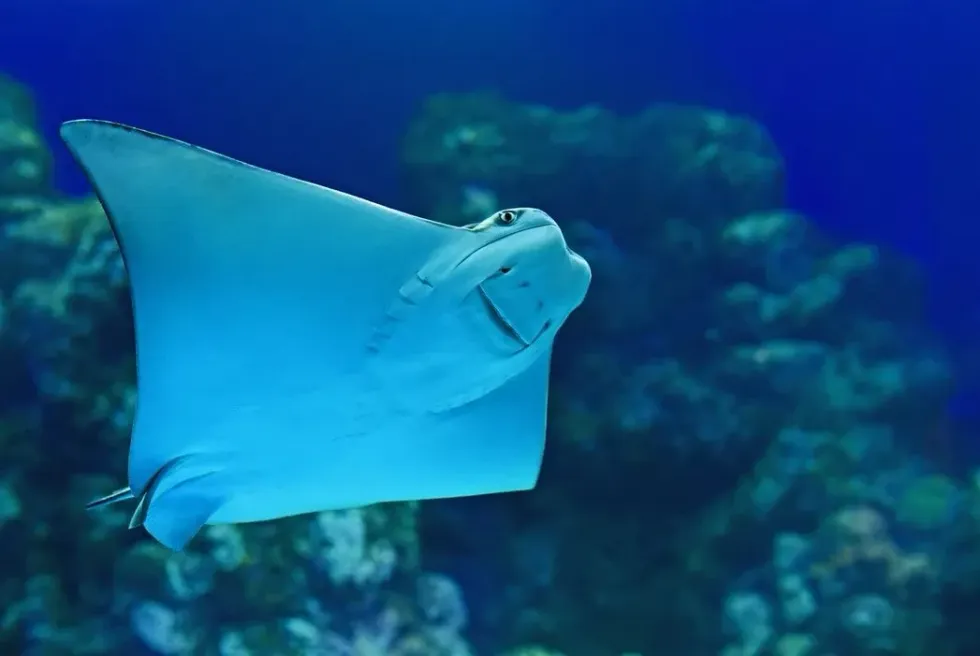The eagle rays are a type of cartilaginous marine fishes belonging to the eagle ray family Myliobatidae. The group consists of around 12 species of flat, disk-like fishes with wing-like pectoral fins. These species have a global distribution and mostly inhabit the warm tropical and temperate waters of the ocean and sea.
The most well-known eagle ray is the white-spotted eagle ray (Aetobatus narinari) of the family Myliobatidae and genus Aetobatus.
Also known as the blue and white-spotted eagle ray, these rays are easily identified by their dark or inky blue upper surface covered in a pattern of white spots and an extremely long tail adorned with venomous spines.
Besides the white-spotted eagle ray (Aetobatus narinari), some other species of eagle ray include the longheaded eagle ray (Aetobatus flagellum), the common eagle ray (Myliobatis aquila), and the bull ray (Aetomylaeus bonus), among others.
So, eagle ray vs. stingray - are they the same animals? While it's quite easy to confuse an eagle ray with a stingray, there is a striking difference between the two; the pectoral fins of the stingrays are round on the edges, but those of the eagle rays are pointed and are more wing-like.
There are many more spotted eagle ray fun facts for you to read. Go ahead and check out all the spotted eagle ray facts!
If you like reading these spotted eagle ray facts, you can also take a look at facts about the cockle and the black neon tetra.
Eagle Ray Interesting Facts
What type of animal is an eagle ray?
An eagle ray is a marine cartilaginous fish.
What class of animal does an eagle ray belong to?
Eagle rays belong to the class Chondrichthyes that includes fishes with skeletons made up of cartilage.
How many eagle rays are there in the world?
There are about a dozen species of eagle rays found globally, which includes the spotted eagle rays as well. Most species are endangered or near-threatened in their wild habitat in the sea and ocean with a decreasing population trend. However, the exact number of eagle rays extant in the world is not known.
Where does an eagle ray live?
Eagle rays live in the open waters of the ocean and the sea of the temperate and tropical regions and have a global distribution. These fishes also inhabit shallow coastal waters, bays, and coral reefs and are spread throughout the Atlantic, Pacific, and Indian Oceans.
What is an eagle ray's habitat?
Eagle rays, including the spotted eagle rays, are found in the tropical and warm temperate waters of the Indian Ocean, Pacific Ocean, and Atlantic Ocean. The spotted eagle ray habitat is specifically associated with reefs, and they are most commonly found along the edges of coral reefs.
The spotted eagle ray prefers warm waters with soft floors made of sand, mud, and gravel and may as well be spotted in beaches, mangrove swamps, and estuaries of the tropics.
Who do eagle rays live with?
Eagle rays (including spotted eagle rays) may be seen swimming along the surface of open waters alone, in pairs, or in groups called schools.
How long does an eagle ray live?
Spotted eagle rays and most other species of this fish are believed to have a lifespan of almost 25 years.
How do they reproduce?
Most information is available about the reproductive biology of the spotted eagle rays. The mating season is usually around mid-summer when a single female spotted eagle ray is pursued by one or several males.
Copulation lasts for around 20-90 seconds. Spotted eagle rays are ovoviviparous, meaning that the females carry the eggs inside her body and give birth to the live young.
After a gestation period of between eight and 12 months, the female spotted eagle ray gives birth to up to four offspring. Each newborn spotted eagle ray has a disk size of around 6.7–13.8 in (17–35 cm), and they mature at about five years of age.
What is their conservation status?
The International Union for Conservation of Nature (IUCN) has placed many species of eagle ray fish under different conservation categories. For example, the white-spotted eagle ray (Aetobatus narinari) is Endangered, the purple eagle ray is Near Threatened, the Pacific eagle ray (Aetobatus laticeps) is Vulnerable, and the shortnose eagle ray (Myliobatis ridens) is Critically Endangered.
Eagle Ray Fun Facts
What do eagle rays look like?

In general, all eagle rays have a disk-shaped body, a long tail, and pointed pectoral fins that look like wings. The eagle ray barb is basically a venomous stinger, a series of which are present on the base of their whip-like tail, behind the pelvic fins.
The spotted eagle rays have a disk-like muscular body that is thick and angular and a flat, rounded, and broad snout that looks like a duck's bill.
The teeth of the spotted eagle ray are broad and flat, arranged in a single file in each jaw. The teeth in the upper and lower plates are ideal for crushing and grinding shelled prey that these fish consume.
Respiratory organs called spiracles are located behind the eyes. The skin of the spotted eagle ray is smooth and devoid of any spines or denticles. The dorsal (upper) side of the disk-like body is bluish, dark gray, or black in color with a unique pattern of white spots. The ventral surface (belly) is white.
How cute are they?
Eagle rays look quite cute with their rounded snout. The spotted eagle ray species look beautiful and magnificent with their pattern of white spots against the backdrop of a dark-colored body.
How do they communicate?
All eagle rays, including the spotted eagle rays, communicate via special electrosensory organs known as the ampullae of Lorenzini. These sensory organs increase the rays' sensitivity to the presence of prey.
Furthermore, these fish have exceptional vision and smell, which aid them in detecting prey and avoiding predators. A lateral line system lets the fish sense changes in water temperature and pressure while they swim.
How big is an eagle ray?
Spotted eagle rays can have an average length of 16.4 ft (5 m) and a wingspan of around 10 ft (3 m). The tail is 2.5-3 times the breadth of the disk. A spotted eagle ray is about twice the size of the common stingray.
How fast can an eagle ray swim?
While there is no concrete information regarding how fast these fish can swim, underwater observations suggest that the spotted eagle ray is an active swimmer, moving gracefully through the waters and moving its pectoral fins in a way that makes it look like a flying bird.
How much does an eagle ray weigh?
Adult spotted eagle rays can weigh up to 507 lb (230 kg).
What are their male and female names of the species?
The male and female eagle rays do not have any specific names.
What would you call a baby eagle ray?
A baby eagle ray is called a pup.
What do they eat?
The diet of the eagle rays comprises small fish, mollusks, crustaceans, echinoderms, and worms.
Are they friendly?
Eagle rays can be really friendly and playful.
Would they make a good pet?
Eagle rays, including the spotted eagle rays, are docile creatures and will make good pets. They are not really dangerous and aggressive unless mishandled. An eagle ray's sting can inflict serious wounds but will not kill humans, though they are too large to be kept as pets and should be left alone in the wild where they belong.
Did you know...
Spotted eagle rays can go to ocean depths of about 197 ft (60 m) but may dive deeper to about 262 ft (80 m).
A spotted eagle ray jumping is a beautiful sight to behold, these rays leaping out of the water and flying through the air.
Even though spotted eagle rays have a fleshy body, it is not desirable to eat them.
Spotted eagle rays have two sets of gills on the ventral side of their body. They breathe in oxygen through the spiracles (on the dorsal side) and breathe out through the gills.
Great hammerhead sharks, silvertip sharks, bull sharks, lemon sharks, and tiger sharks are the principal predators of eagle rays.
How does an eagle ray defend itself?
Eagle rays have venomous stingers on their tails that are used as defensive weapons against predators or other threats.
What are an eagle ray's teeth like?
Eagle rays use their plate-like teeth to crumble and grind their prey. Its prey includes Oysters, shrimp, clams and sea urchins.
Here at Kidadl, we have carefully created lots of interesting family-friendly animal facts for everyone to discover! Learn more about some other fish including rays and cownose rays.
You can even occupy yourself at home by drawing one of our Eagle ray coloring pages.










